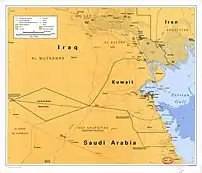Kuwait–Saudi Arabia border
The Kuwait–Saudi Arabia border is 221 km (137 m) in length and runs from the tripoint with Iraq in the west to the Persian Gulf coast in the east.[1]
Description
The border starts in the west the tripoint with Iraq on the Wadi Al-Batin; a straight line of 90 km (55 m), angled slightly to the south-east, then proceeds eastwards. The border then turns southwards via a series of irregular lines, before turning sharply to the east, with a straight line of 70 km (43 m) running to the Gulf coast.
History
.jpg.webp)
Historically there was no clearly defined boundary in this part of the Arabian peninsula; at the start of the 20th century the Ottoman Empire controlled what is now Iraq and Britain controlled Kuwait as a protectorate, with the interior consisting of loosely organised Arab groupings, occasionally forming emirates, most prominent of which was the Emirate of Nejd and Hasa ruled by the al-Saud family.[2][3] Britain and the Ottoman Empire theoretically divided their realms of influence via the so-called 'Blue' and 'Violet lines' in 1913-14, by which the Ottomans recognised British claims on Kuwait, divided from Ottoman Mesopotamia along the Wadi Al-Batin (the so-called 'green line', see map right).[4][5][6]
During the First World War an Arab Revolt, supported by Britain, succeeded in removing the Ottomans from most of the Middle East; in the period following this Ibn Saud managed to expand his domains considerably, eventually proclaiming the Kingdom of Saudi Arabia in 1932. Ibn Saud claimed Kuwait as part of his new state, attempting to annex it in 1919, resulting in the Kuwait–Najd War; when that failed he instituted a blockade of Kuwait.[7][8]

In December 1922 Percy Cox, British High Commissioner in the British Mandate of Iraq, met with Ibn Saud and signed the Uqair Protocol, which finalised Saudi Arabia’s border with both Kuwait and Iraq.[3] The Treaty also created a large Saudi–Kuwaiti neutral zone in the south-east, where both parties were to share equal rights pending further agreement.[3] When oil was later discovered in this zone it was agreed to partition it in 1965, this division being ratified in 1969-70, at which point the Kuwait-Saudi border was finalised at its current position.[3][9]
Iraq invaded and annexed Kuwait in 1990, breaching the Kuwait–Saudi Arabia border in 1991 at the Battle of Khafji during the Gulf War.[10]
Border Crossings
The two main border crossings are at Salmi and Nuwaiseeb.[11]
See also
References
- CIA World Factbook – Saudi Arabia, retrieved 31 March 2020
- Madawi Al-Rasheed. A History of Saudi Arabia. Cambridge, England, UK: Cambridge University Press, 2002. Pp. 40.
- International Boundary Study No. 103 – Kuwait-Saudi Arabia Boundary (PDF), 15 September 1970, retrieved 1 April 2020
- Briton Cooper Busch, Britain and the Persian Gulf, 1894-1914 (Berkeley: University of California Press,1967), 308, and 319.
- Richard Schofield (31 March 1999), Negotiating the Saudi-Yemeni international boundary, Al-Bab, retrieved 30 March 2020
- Harry Brown (October 1994), The Iraq-Kuwait boundary dispute: historical background and the UN decisions of 1992 and 1993, IBRU Boundary and Security Bulletin, retrieved 1 April 2020
- Michael S. Casey (2007). The History of Kuwait. pp. 54–55. ISBN 9781573567473.
- Mary Ann Tétreault (1995). The Kuwait Petroleum Corporation and the Economics of the New World Order. pp. 2–3. ISBN 9780899305103.
- "Archived copy". Archived from the original on 2005-01-09. Retrieved 2005-12-02.CS1 maint: archived copy as title (link)
- Titus, James (1996). "The Battle of Khafji: An Overview and Preliminary Analysis" (PDF). Defense Technical Information Center. Retrieved 11 September 2019.
- "Flights & getting there in Kuwait".

